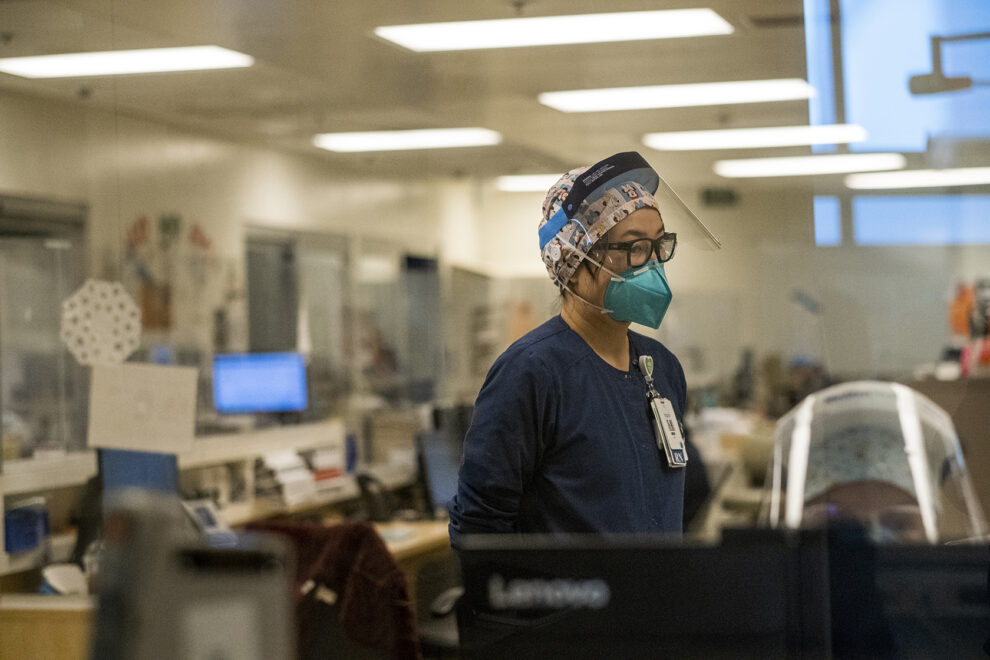Hospitals are frustrated with a nationwide nursing shortage that’s only gotten worse since the pandemic. In 2022, the American Hospital Association quoted an estimate that half a million nurses would leave the field by the end of that year, bringing the total shortage to 1.1 million.
At the same time, National Nurses United insists there isn’t a nurse shortage at all. There are plenty enough nurses for the country, they say — merely a shortage of nurses who want to work under current conditions.
Experts told STAT that everyone — including patients who are frustrated that they’re not getting proper nursing care — is a little bit right, though not in the way they might expect. Linda Aiken, the founding director of the Center for Health Outcomes and Policy Research at the University of Pennsylvania, said that the problem is a shortage of nursing care.
“These two things can exist at one time,” she said. “You can have a lot of nurses, but really at the intersection of care that’s delivered to the public, you could have a shortage because those institutions are not hiring enough of them.”
According to nurses, this behavior makes health care workers frustrated and want to quit, making the cycle worse.
This is all coming to a head in health care worker strikes — at SSM, at Prime Healthcare hospitals, at Kaiser Permanente — where workers have focused on understaffing, not pay, as their top priority. They want more staff on the floor so they can provide the appropriate care to their patients. Hospitals, on the other hand, are frustrated with higher labor costs driven by the temporary contract travel nurses they have to hire to care for their patients and don’t see the problem abating without an infusion of new nurses for them to hire.
To that end, the Biden administration recently approved $100 million to grow the nursing workforce. “It’s always nice to have more funding for nursing,” said Aiken, “but that kind of untargeted investment will not do anything whatsoever to solve the problem that the public is concerned about, which is [that] there are not enough nurses providing care where they are needed.”
For hospitals, it sure feels like a shortage
The “nursing shortage is real,” Tenet Healthcare executive chairman Ron Rittenmeyer said in a radio interview in early 2022, blaming it on nurses leaving staff positions for lucrative travel jobs, nurses contracting Covid-19, and not enough support for nursing education.
Even as the pandemic has subsided in the past year, health care systems including Tenet, HCA, Universal Health Services, and Acadia Healthcare have said in financial guidance documents that they’re experiencing staff shortages, as well as turnover and retention problems. The hospitals are competing with each other for staff, which has driven up wages.
An interviewer at the Bank of America Healthcare Conference in May 2023 suggested to Tenet CEO Saum Sutaria that the contract labor problem could be eliminated if wages for in-house staff were raised, which Sutaria dismissed. “You could increase wages incredibly — you can increase them twice the normal rate, and I still don’t think there would be enough staff to come in and take full time,” he said. “There’s still a shortage, in the end of the day, of nurses, and this becomes an execution game of attracting people to your hospitals versus others.”
Nurses say there’s no shortage at all
For nurses, what would attract them to one hospital over another or keep them from leaving the field is having enough other trained nurses and support staff — nurse techs, CNAs, phlebotomists, lab techs — to make their job doable.
Nurses say they are sick of what they call a “manufactured” staffing crisis. “It’s a little bit of an odd thing because they’re all yelling, ‘Nursing shortage, nursing shortage!’” Aiken said. But “[hospitals] have been chronically understaffing by design for several decades, and the same thing in nursing homes and schools.”
Nurses say hospitals maintain such low numbers of staff that there’s not enough time in the day to do everything required, much less do it well. The unmanageable workload leads nurses to question whether they want to stay in that environment and face the repercussions of making a mistake, said Leo Perez, a nurse at Pomona Valley Hospital Medical Center in California and president of the SEIU 121RN union. “I mean, you heard about what happened [to RaDonda Vaught],” the Tennessee nurse who was charged with negligent homicide for injecting a patient with the wrong medication, he said.
The conditions make it hard to hold on to nurses, contributing to the idea that there is indeed a shortage. Sarah DeWilde, a nurse at St. Louis University Hospital, said that as part of SLU’s nursing union, she looked at how many nurses had been hired since the last contract was signed three years ago. She had expected to find a couple hundred. But it turned out that was a major underestimate: The hospital had hired about 1,600 nurses in the last three years, and that still wasn’t enough. “They’re just not sticking around,” said DeWilde.
While the hospital needs about 850 nurses, it currently has about 575 on staff. The deficit of around 300 nurses has persisted for the last two years, as nurses quit about as quickly as more could be hired, according to the National Nurses Organizing Committee, which represents SLU nurses. The hospital hires travel and agency nurses to try to fill in the gaps.
While hospitals are complaining about shortages, health care workers told STAT that they perceived the understaffing as intentional; hospitals will hire, but not to capacity. Retired colleagues won’t get replaced. Some vacancies never get posted. “‘You nurses can do it,’” DeWilde said is the refrain when they are short-staffed. Concerns over understaffing drove the Kaiser Permanente health care worker strike and motivated St. Louis University Hospital nurses to strike for one day in September.
“[Hospitals] staff in order to maximize profits,” said Jean Ross, co-president of National Nurses United. “It used to be they tried to talk around that a little bit, do a little spin. [Now] they’ll come right out and say it: ‘Our profit margins, our profit margins.’”
What does the data say?
In its statement decrying the use of the term “nurse shortage,” National Nurses United cited three statistics: There are 1 million more registered nurses than are currently employed as nurses; the number of candidates who are passing the nurse licensure exam for the first time is continually growing; and the registered nurse workforce is growing — but just in settings other than acute care, such as insurance or ambulatory care. (The NNU published its memo in May 2023, when the tally of registered nurses was 4,604,199; when STAT checked this month, that number had grown by more than 100,000 to 4,708,451.)
Given those numbers, “I would say it’s pretty hard to conclude that we have a shortage of nurses,” said Aiken.
But how many nurses does the country truly need? Is it possible that it is still more than the number of nurses we have? MaryAnn Alexander, chief officer of nursing regulation at the National Council of State Boards of Nursing, said she doesn’t have the answer. “And I’m not sure anybody knows,” she said.
The demand for nurses generally increases over time as chronic disease management gets better and hospitalized patients’ care gets more complex — they don’t just have pneumonia, but pneumonia and kidney failure. And “even healthy people fall, get the flu,” and get joint replacements, said Alexander. “All of that is increasing as the population lives longer, and thus we need more nurses.”
Besides the increased demand for nurses, many arguments for the existence of a nurse shortage propose that the number of retirements and other people leaving the workforce are greater than the number of nurses graduating into the workforce.
But Aiken said that simply isn’t true, pointing to studies that say that the country is accumulating nurses faster than ever. The number of nurses per capita doubled between 1980 and 2020, and projections say that not only are there enough nursing school graduates to replace those retiring, but by 2035, the nursing workforce will have expanded by 1.2 million.
The California approach to increasing nursing care
The difference between a “nurse shortage” and a “shortage of nursing care” is the difference between the amount of nurses living in a state and the nurse-to-patient ratio in a hospital, according to Aiken. One is the number of people available to work, the other is directly related to patient care. Even though California had one of the lowest numbers of nurses per capita in 2004, when the state implemented mandatory nurse-to-patient ratios, its hospitals were able to meet the staffing standard. Patients received nearly three more hours of nursing care per day compared with states that didn’t have minimums. The mortality of patients is highly correlated to the nurse-to-patient ratio. The better care environment after the ratios passed caused nurses to flock to California.
“California has my best friend,” DeWilde said with a bitter laugh. “She moved out there because she preferred working in a safer work environment, better ratios, making sure she gets a break and she gets lunch and she gets to go pee. Those are all guarantees out there.”
Until this summer, California was the only state to have such a rule — Oregon’s recently passed law will go into effect in June 2024.
The federal government even has a mechanism it could use to introduce such ratios: participation in Medicare, said Aiken. This approach was used — and stood up to legal challenges — to implement mask mandates in hospitals during the pandemic, and to desegregate hospitals and implement no-smoking policies. It’s also currently being used to implement controversial nursing home staffing ratios.
But even in California, the ratio implementation isn’t perfect. Waivers were handed out during the pandemic and standards slipped, nurses said. Unions lobbied for the California Department of Public Health to re-enforce safe staffing laws, which the department only announced it would do in September 2023.
How do hospitals feel about increasing staff?
Hospitals argue that ratios could lead some facilities to close altogether.
Earlier this year, the Minnesota Hospital Association lobbied aggressively to get minimum staffing standards cut out of the state’s proposed Keeping Nurses at the Bedside Act, which would have implemented ratios, effectively increasing the number of nurses hospitals have to hire. The association said there were already 5,000 vacant registered nurse positions in the state and warned that the legislation would reduce care capacity by 15%, threaten care for 70,000 Minnesotans annually, and result in the closure of hospitals.
Mayo Clinic, an international health care giant, didn’t like the bill, either. It gave the Minnesota governor and legislature an ultimatum: Cut the staffing provisions in the bill, or the health care system would pull more than $4 billion in investments out of the state. The staffing provisions were removed from the bill at the last minute, leading the Minnesota Nurses Association to lament that the state and health care system executives were putting profits before patients.
HCA, one of the largest hospital systems in the country, wrote in its own regulatory filings that if more states implemented ratios, it could raise labor costs significantly and “have an adverse impact on revenues if we are required to limit patient admissions in order to meet the required ratios.”
The HCA campaigned against a proposal to increase oversight of understaffing at its shareholder meeting earlier this year. The proposal that the HCA’s Patient Safety and Quality of Care Committee should have oversight over staffing levels came from stockholder Michael Frerichs, who also serves as the Illinois state treasurer. He cited reports that HCA’s staffing levels are 30% below the industry average, as well as a survey that 89% of HCA health care workers said short-staffing was affecting patient care. Better oversight on staffing “is crucial for effective risk management and protection of long-term shareholder value,” he argued.
The board recommended voting against the proposal, saying that it believed “our staffing levels are safe and appropriate” and that the company’s existing structures already provide the appropriate level of oversight and management of staffing levels, thus the proposed changed would not “result in any meaningful benefit to our patients.”
In fact, the health care system said, staffing depends on a lot of factors, including the potential for surges in patients on a given day; the number, type, licensure, and skills of staff available for scheduling; and the acuity and complexity of patient conditions. Deb Zimmerman, the president-elect of the American Organization for Nursing Leadership, an affiliate of the American Hospital Association, agreed.
“Mandated nurse staffing ratios remove real-time clinical decision making and flexibility from the nurses when it comes to determining the right type and level of care for their patients,” she said.
Zimmerman struggled to come up with a reason why there shouldn’t be mandated minimums, though. “To me, it’s not a number and it’s not something that can be legislated. It needs to be done between the nurses and the teams and it’s dependent on the type of organization they are,” she said.
However, Ross at NNU said that process isn’t always a conversation. Years ago, when a charge nurse said they needed more staff, the response would be, “We’re trying.”
“Now they don’t even lie and say they’re trying,” she said. “It’s just, ‘No, you have as many as the grid allows,’ ‘You have as many as our financial situation says you will have. Do the best you can.’”
To nurses like DeWilde, it feels like it should be much simpler than that. “What’s wrong with an extra set of hands?”
Source : Statnews
















